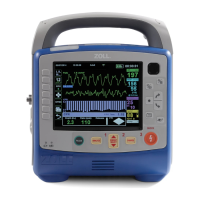Pacing in Demand Mode
9650-001355-01 Rev. M X Series Operator’s Guide 18-5
8 Determine Capture
It is important to recognize when pacing stimulation has produced a ventricular response
(capture). Determination of capture must be assessed both electrically and mechanically in
order to ensure appropriate circulatory support of the patient.
Electrical capture is determined by the presence of a widened QRS complex, the loss of any
underlying intrinsic rhythm, and the appearance of an extended, and sometimes enlarged,
T-wave.
Ventricular response is normally characterized by suppression of the intrinsic QRS complex.
WARNING! Determination of electrical capture should only be performed by viewing the ECG trace
on the X Series display with its ECG connection directly attached to the patient. Use of
other ECG monitoring devices might provide misleading information due to the
presence of pacer artifacts.
Mechanical capture is assessed by palpation of the peripheral pulse.
To avoid mistaking muscular response to pacing stimuli for arterial pulsations, use ONLY the
following locations for palpating pulse during pacing:
• femoral artery
• right brachial or radial artery
Effective pacing
Changing ECG leads and size can sometimes be helpful in determining capture.
Note: The shape and size of the paced ECG waveforms can vary depending on the ECG lead
configuration chosen; variation from patient to patient can be expected.
9 Determine Optimum Threshold
The ideal pacer current is the lowest value that maintains capture — it is usually about 10%
above threshold. Typical threshold currents range from 40 to 80 mA. Location of the hands-free
or therapy electrodes affects the current required to obtain ventricular capture. Typically the
lowest threshold is obtained when the position of the electrodes provides the most direct current
pathway through the heart while avoiding large chest muscles. Lower stimulation currents
produce less skeletal muscle contraction and are better tolerated.

